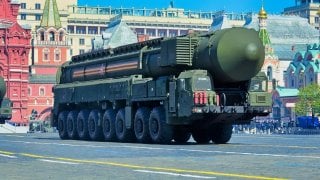America’s Oreshnik Hypersonic Weapons Nightmare Has Begun
Russia’s possession of the Oreshnik alters the balance of power, both in Ukraine and in the wider international system. The only other nation that comes close to Russia’s hypersonic capabilities is Moscow’s good friend China.
After vowing to retaliate against the West because Western leaders in America and Britain authorized Ukraine to fire long-range missiles into Russia, the Russian military attacked Dnipro with a long-range hypersonic missile. Known as the “Oreshnik,” this long-range nuclear-capable hypersonic weapon is virtually unstoppable.
That’s because the West (or any power today) lacks a reliable defense system against these radical new weapons.
Traveling at Mach 10 (over 7,500 miles per hour), with a range of around 3,000 miles, and radically maneuvering while in route to its target, the Oreshnik arrived over Dnipro, Ukraine, where it subsequently separated into smaller ordnance and hit multiple targets in the area. Initially, there was worry that the hypersonic weapon had been loaded with nukes. It was not, but the next time this weapon is lobbed at Western forces, it very well may be.
The Context of Russia’s Attack
That was partly the point of the Oreshnik’s firing at Dnipro. Vladimir Putin was signaling to Russia's rivals that the Russians are prepared to go all the way up to—and including—nuclear warfare to preserve their standing in Ukraine. Especially after NATO authorized significant escalation against Russia when they allowed for American ATACMS and British Storm Shadow missiles to be fired by Ukraine at Russia.
This system can reach anywhere in Europe as well as the west coast of the United States.
It is believed that the Oreshnik could carry six to eight conventional or nuclear warheads. Thankfully, no immediate escalation occurred as a result of the Russian launch of this system. But that was only because it is believed that the Russians alerted the Americans through nuclear deconfliction channels that the attack was coming and that it was non-nuclear. When the Russians decide that they can no longer tolerate the Americans and their allies’ continuing escalation and opt to instead launch a nuclearized Oreshnik at European or American targets, no warning will come.
Make a Deal to Stop the Hypersonic Threat
Russia’s possession of the Oreshnik alters the balance of power, both in Ukraine and in the wider international system. The only other nation that comes close to Russia’s hypersonic capabilities is Moscow’s good friend China. America, despite its leaders being full of bluster, neither has a working arsenal of hypersonic weapons nor a reliable defense against these devastating systems. With Russia’s defense industrial base obviously doing better than that of the United States, which can barely maintain the output needed to sustain Ukrainian forces, the Oreshnik’s arrival as a serious player on the battlefield means that no one in the West is safe.
Unable to create its own arsenal of hypersonic weapons to rival the Oreshnik and lacking any viable defense against these systems, now would be the time for any rational American leader to deescalate.
Brandon J. Weichert, a National Interest national security analyst, is a former Congressional staffer and geopolitical analyst who is a contributor at The Washington Times, the Asia Times, and The-Pipeline. He is the author of Winning Space: How America Remains a Superpower, Biohacked: China’s Race to Control Life, and The Shadow War: Iran’s Quest for Supremacy. His next book, A Disaster of Our Own Making: How the West Lost Ukraine, is available for purchase wherever books are sold. Weichert can be followed via Twitter @WeTheBrandon.

